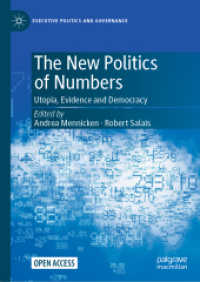- ホーム
- > 洋書
- > 英文書
- > Computer / Languages
Full Description
This text is intended for either a one-semester accelerated introductory course or a traditional two-semester sequence covering C++ programming. It is also suitable for readers interested in a comprehensive introduction to C++ programming. ' Tony Gaddis's accessible, step-by-step presentation helps beginning students understand the important details necessary to become skilled programmers at an introductory level. Gaddis motivates the study of both programming skills and the C++ programming language by presenting all the details needed to understand the "how" and the "why"-but never losing sight of the fact that most beginners struggle with this material. His approach is both gradual and highly accessible, ensuring that students understand the logic behind developing high-quality programs. ' In Starting Out with C++: From Control Structures through Objects, Gaddis covers control structures, functions, arrays, and pointers before objects and classes. As with all Gaddis texts, clear and easy-to-read code listings, concise and practical real-world examples, and an abundance of exercises appear in every chapter. ' MyProgrammingLab for Starting Out with C++ is a total learning package.MyProgrammingLab is an online homework, tutorial, and assessment program that truly engages students in learning. It helps students better prepare for class, quizzes, and exams-resulting in better performance in the course-and provides educators a dynamic set of tools for gauging individual and class progress. ' Teaching and Learning Experience This program presents a better teaching and learning experience-for you and your students. It will help: *Personalize Learning with MyProgrammingLab: Through the power of practice and immediate personalized feedback, MyProgrammingLab helps students fully grasp the logic, semantics, and syntax of programming.*Enhance Learning with the Gaddis Approach: Gaddis's accessible approach features clear and easy-to-read code listings, concise real-world examples, and exercises in every chapter. *Keep Your Course Current: This edition introduces many of the new C++11 language features.*Support Instructors and Students: Student and instructor resources are available to expand on the topics presented in the text. Note: You are purchasing a standalone product; MyProgrammingLab does not come packaged with this content.If you would like to purchase both the physical text and MyProgrammingLab' search for ISBN-10: 0133796337/ISBN-13: 9780133796339. That package includes ISBN-10: 0133769399/ISBN-13: 9780133769395' and ISBN-10: 0133780619 /ISBN-13: 9780133780611. MyProgrammingLab is not a self-paced technology and should only be purchased when required by an instructor. '
Contents
Introduction to Computers and Programming 1 CHAPTER 2 Introduction to C++ 27 CHAPTER 3 Expressions and Interactivity 85 CHAPTER 4 Making Decisions 149 CHAPTER 5 Loops and Files 227 CHAPTER 6 Functions 301 CHAPTER 7 Arrays 377 CHAPTER 8 Searching and Sorting Arrays 451 CHAPTER 9 Pointers 491 CHAPTER 10 Characters, C-Strings, and More About the String Class 541 CHAPTER 11 Structured Data 593 CHAPTER 12 Advanced File Operations 651 CHAPTER 13 Introduction to Classes 705 CHAPTER 14 More About Classes 799 CHAPTER 15 Inheritance, Polymorphism, and Virtual Functions 869 CHAPTER 16 Exceptions, Templates, and the Standard Template Library (STL) 947 CHAPTER 17 Linked Lists 1003 CHAPTER 18 Stacks and Queues 1043 CHAPTER 19 Recursion 1101 CHAPTER 20 Binary Trees 1137 Appendix A: Getting Started with Alice 1167 Appendix B: The ASCII Character Set 1195 Appendix C: Operator Precedence and Associativity 1197 Quick References 1199 Index 1201 Online The following appendices are available at www.pearsonhighered.com/gaddis Appendix D: Introduction to Flowcharting Appendix E: Using UML in Class Design Appendix F: Namespaces Appendix G: Writing Managed C++ Code for the .NET Framework Appendix H: Passing Command Line Arguments Appendix I: Header File and Library Function Reference Appendix J: Binary Numbers and Bitwise Operations Appendix K: Multi-Source File Programs Appendix L: Stream Member Functions for Formatting Appendix M: Introduction to Microsoft Visual C++ 2010 Express Edition Appendix N: Answers to Checkpoints Appendix O: Solutions to Odd-Numbered Review Questions








